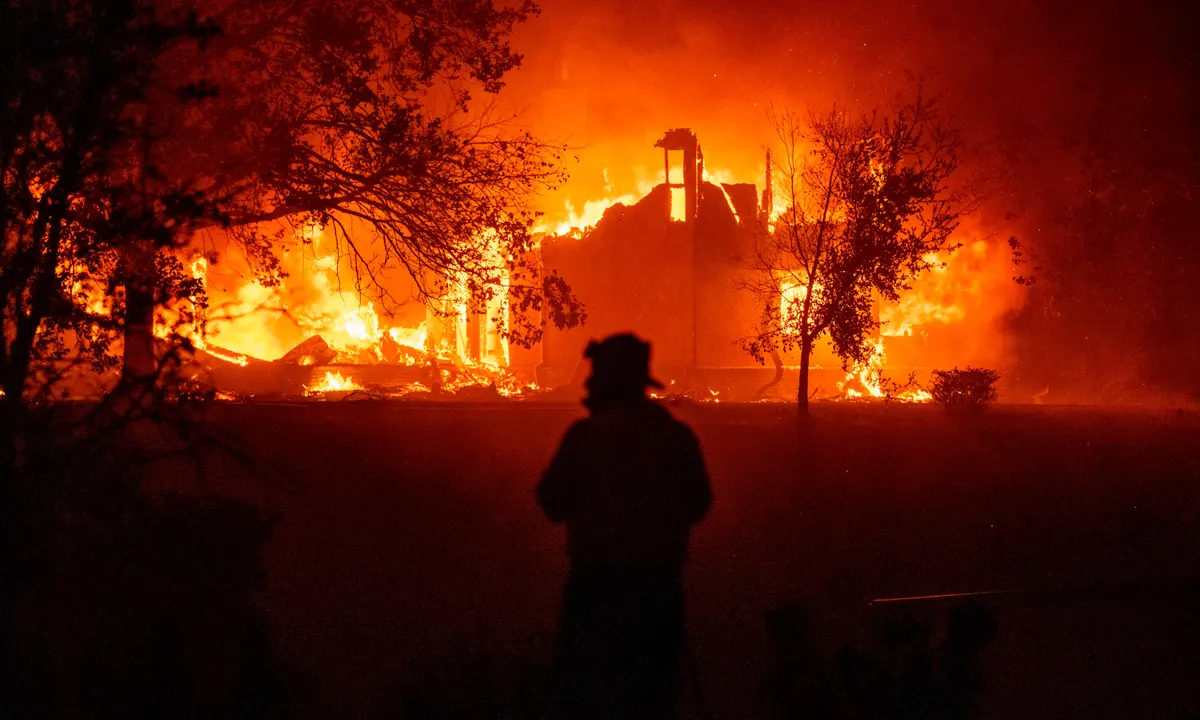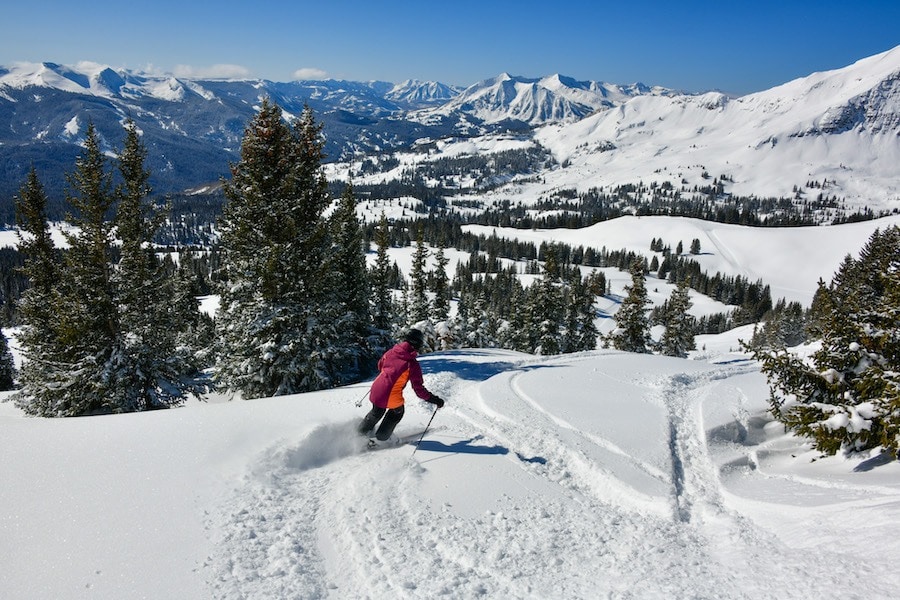Located only 22 miles off the tailspin of Southern California, Catalina Island is an inhabited island that offers wondrous kelp forest diving, wildlife, and turns out…some pretty epic camping, hiking, and backpacking on the Trans Catalina Trail.
The Trans Catalina Trail is a 40-mile trail that traverses the unshortened island with wondrous beachfront camping, some challenging climbs, non-stop views, solitude (in November when I hiked), and plane a couple of restaurants withal the way.
I grew up going to Catalina, so when I learned well-nigh the Trans Catalina Trail, I knew I had to do it. So I organized trip for Ryan, myself, and flipside friend, and we spent 5 days transversing the hillsides and coastlines of this California treasure.
It was a fantastic trip that I’d highly recommend for anyone who is looking for outdoor venture in Southern California. Backpacking the Trans Catalina Trail is moreover a trip you can do long without backpacking season is typically over in the mountains. In this post, I share everything you need to know well-nigh hiking the unshortened Trans Catalina Trail.
As it goes in all of the destinations we share, please practice good trail etiquette and remember to Leave No Trace. This ways packing out all of your garbage, stuff respectful to others on rented trails, and pursuit the established rules.
Trans Catalina Trail Stats & FAQs
The Trans Catalina trail runs East-West withal Catalina Island off the tailspin of California. It’s part of the Channel Islands archipelago.
- Total Distance: 38.5 miles
- Total Elevation Proceeds Loss: /-7,940 feet
- Difficulty: Challenging
- Days needed: 2-5 days
- Dogs Allowed: Yes (except for Two Harbors Campground)
- Advanced Reservations Required: Yes (see the next section)
- Number of Recommended Nights: 4 nights / 5 days (minimum)
- Cell Service: Sporadic
TransCatalina Trail Map
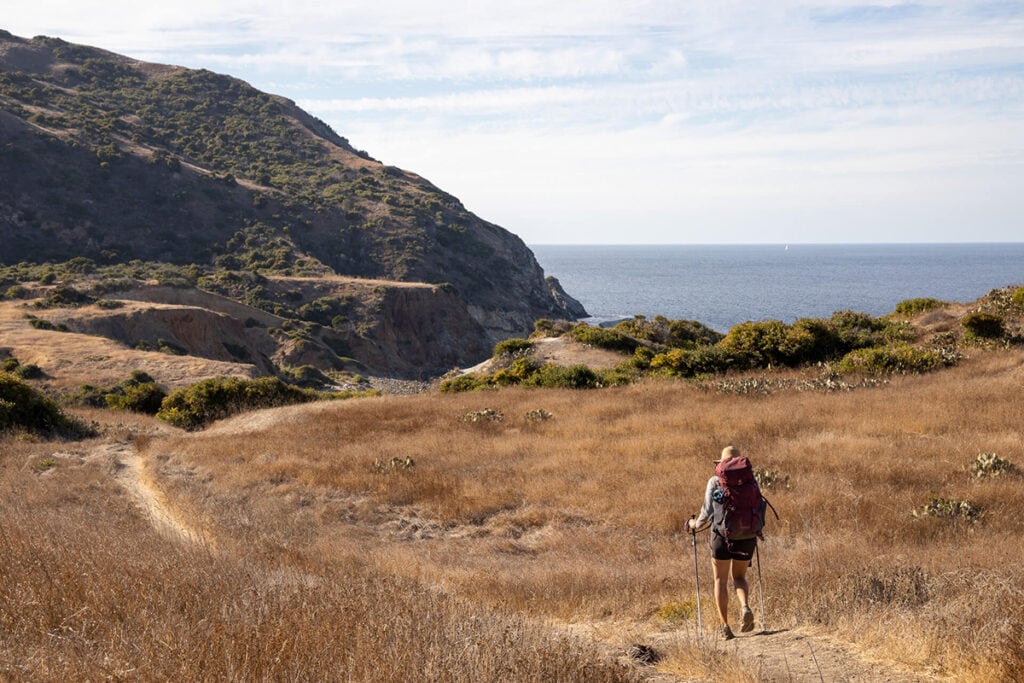
The full trail 38.5 miles. Hikers typically start in Avalon and end in Two Harbors without hiking a loop virtually the northwest peninsula of the island.
Most people hike the Trans Catalina Trail in 3-5 days. See unelevated for itinerary options.
the Trans Catalina Trail is no walk in the park — it is hard. Over the undertow of the trip, there is plenty of up, down, up, lanugo – in total over 7,940 feet in elevation gain/loss.
There is moreover a lot of sun exposure and no shade withal the trail, meaning it can get very hot in peak summer months so be sure to bring sun protection.
With that stuff said, this hike wideness Catalina Island takes you through an incredibly unique and trappy ecosystem, and the wits was increasingly than worth the challenge. There are moreover some volitional route options you can take if you want to stave some of the elevation proceeds and loss or if you simply don’t have unbearable time for the unshortened route (I share some volitional itineraries below).
This is not a traditional wilderness backpacking trip. Some of the hike is right on the road where you will encounter the occasional vehicle.
Also, at the Airport, you’ll find a restaurant serving breakfast and lunch and in Two Harbors, they have a full-blown unstipulated store, restaurant, and bar.
Yes, the TCT is well-marked. However, I still recommend picking up a map at the Catalina Island Conservancy shop where you can purchase a detailed Trans Catalina Island Trail map.
This one-way trail can be traveled in either direction, but I recommend starting in the town of Avalon and ending your hike at Parson’s Landing (returning on the ferry via Two Harbors). In this direction, the views and solitude only modernize as you hike.
Your camping reservations will serve as your permit to hike the Trans Catalina Trail, so be sure to siphon a reprinting with you. (See increasingly well-nigh camping below)
You don’t need an spare permit unless you will be day hiking on the island, and in that case, you’ll need to request a self-ruling permit.
The most popular TCT backpacking itinerary is 5 days/4 nights. If you’re an experienced hiker, you could do it in 4 days. See increasingly well-nigh planning your itinerary below.
There is no potable water on the trail in between the campgrounds, but water is misogynist at Black Jack, Little Harbor, and Two Harbors campgrounds. For the last night at Parson’s, you’ll need to purchase a locker key that gives you wangle to a 2-gallon jug of water.
I recommend that when you hit the trail each morning, you have at least 3-4 liters of water for the day.
Best time of year to hike the TCT
Catalina Island typically sees increasingly than 260 days of sun per year.
My recommendation is to hike between September through early November for the most well-appointed temperatures and the highest likelihood of sunshine.

- Spring: This is a beautifully vibrant time to hike with untried hillsides and a trail full of wildflowers. Views may be obscured by fog.
- Summer: With a lack of shade on the trail, the summer months can be very hot and dry. There is no water misogynist between campgrounds on a majority of the trail, and the trail can finger much hotter than the temperature might indicate.
- Fall: Comfortable temps and lots of sunshine. The only downside of the fall months is that the landscape is very brown.
- Winter: Most of the rainfall on Catalina Island occurs between December and March, and when it rains in California, it can pour. These months are the riskiest for weather, but then again, you could luck out.
You may have heard the saying “May Gray, June Gloom” for California. During these months, there’s a good endangerment Catalina will be engulfed in fog. Hiking temperatures will be comfortable, but you may not get the sunny California views you are hoping for.
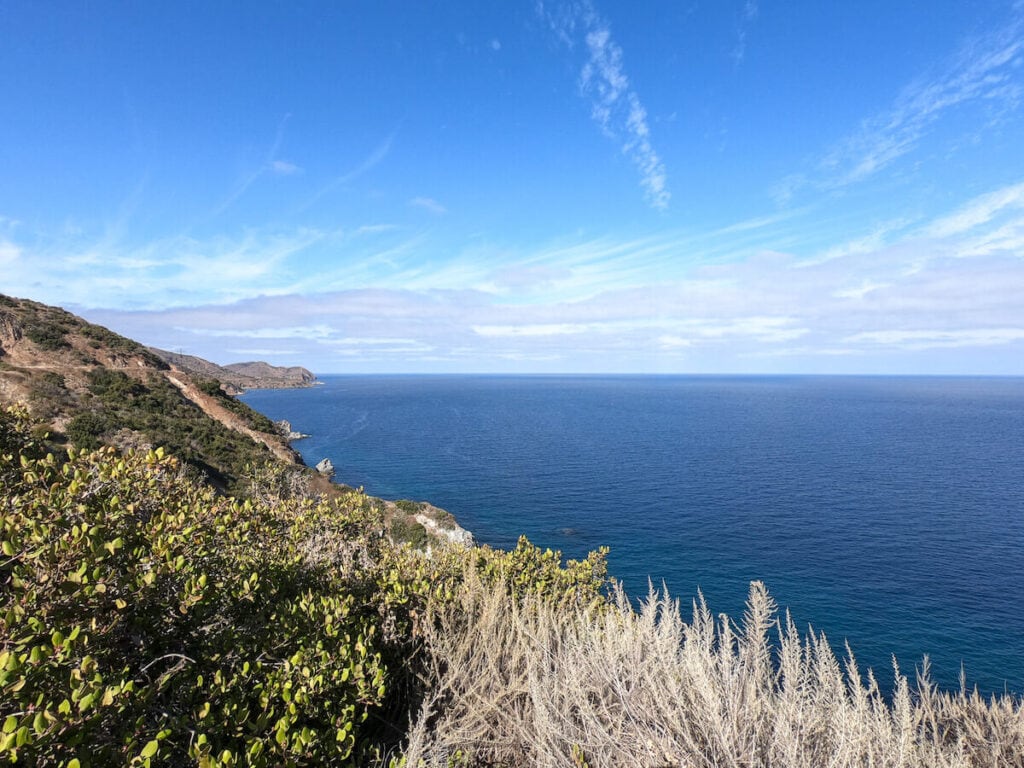
Planning your trip
Backpacking the Trans Catalina Trail does take a good bit of planning between getting there, making campsite reservations, and packing all the necessary gear.
Below I swoop into everything you need to know well-nigh planning your TCT trip.
Choosing an itinerary
The Trans Catalina Trail can be washed-up in 3-5 days. A 3-day trek will be quite challenging with lots of elevation proceeds and longer days.
We wanted to take our time and enjoy the incredible scenery, so we chose a 5-day itinerary, which unliable us to move at a relaxed pace and really take in the experience.
Here are three variegated Trans Catalina trail itineraries:
3-DAY ITINERARY:
- Day 1: Avalon to Blackjack Campground (10.7 miles/ 2,930 ft)
- Day 2: Blackjack to Two Harbors Campground (14.5 miles/ 2,526 ft)
- Day 3: Two Harbors Campground to Parsons Landing and when to Two Harbors (13.6 miles/ 2,289 ft)
4-DAY ITINERARY:
- Day 1: Avalon to Blackjack Campground (10.7 miles/ 2,930 ft)
- Day 2: Blackjack to Little Harbor Campground (8.3 miles/ 987 ft)
- Day 3: Little Harbor to Two Harbors Campground (5.3 miles/ 1,369 ft)
- Day 4: Two Harbors Campground out to Parsons Landing and when to Two Harbors (13.6 miles/ 2,289 ft)
5-DAY ITINERARY:
This is the itinerary we did.
- Day 1: Avalon to Black Jack Campground (10.7 miles/ 2,930 ft)
- Day 2: Black Jack to Little Harbor Campground (consider neighboring Shark Harbor for increasingly solitude) (8.3 miles/ 987 ft)
- Day 3: Little Harbor to Two Harbors Campground (5.3 miles/ 1,369 ft)
- Day 4: Two Harbors to Parsons Landing Campground via the TCT (6.7 miles/ 1,773 ft)
- Day 5: Parsons Landing to Two Harbors via the road and Lion’s Throne (6.9 miles/ 516 ft)
Down unelevated in the trip report, I go into detail well-nigh each day’s trek.
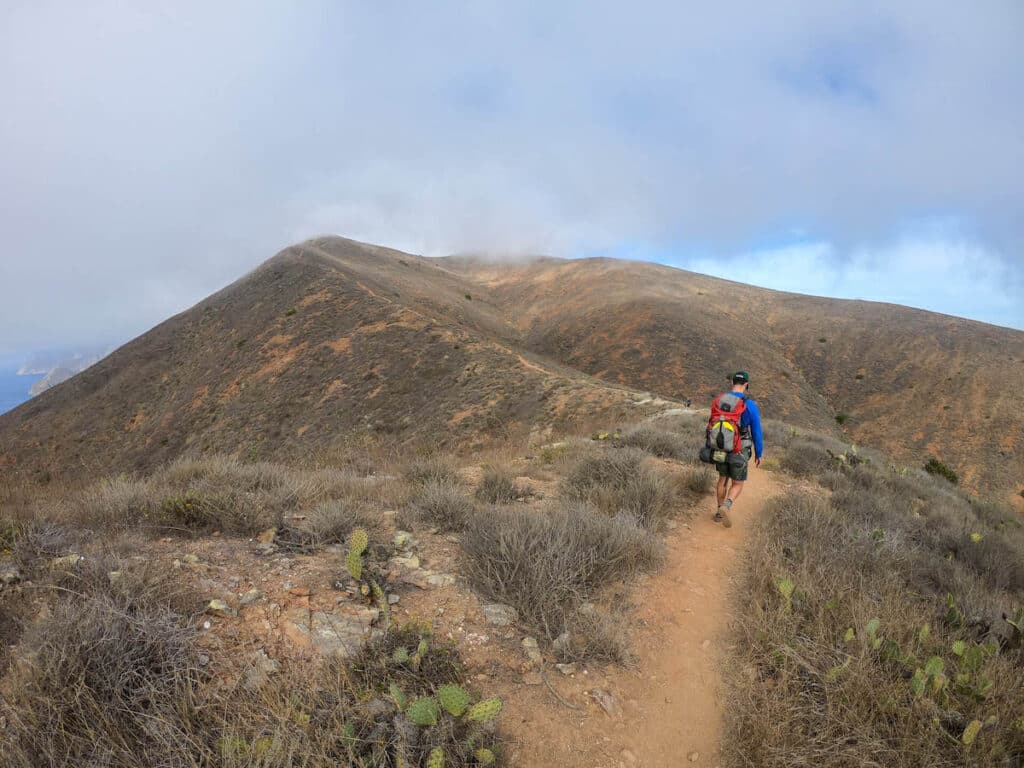
Crunched for time?
If you want to wits the Trans Catalina Trail but don’t have time to do the whole thing, here are a few alternative options:
- Take the ferry directly to Two Harbors and hike the 5-mile stretch from Two Harbors to Little Harbor and back. My friends and I all well-set this was the most scenic section of the trail. Little Harbor is moreover rated “One of the Weightier Campgrounds in the West by Sunset Magazine. This would be a simple 1-2 night getaway.
- Another option would be to take the ferry directly to Two Harbors and hike to Parson’s Landing. This was my favorite campground of the trip and would make a unconfined wiring zany for a couple of nights, with a day hike to Starlight Beach.
Making campsite reservations
There is no free/dispersed camping on Catalina Island, so you need to make campground reservations surpassing you start your trip.
Campsites do typesetting up during the rented summer months, so don’t wait in making your plans, expressly if you are headed to Catalina on a weekend. Campsites can be booked up to a year in advance.
The five campsites withal the Trans Catalina Trail are:
- Hermit Gulch
- Black Jack Campground
- Little Harbor Campground
- Two Harbors Campground
- Parsons Landing Campground
You can book your Catalina Island campsites online. Alimony in mind that since you will be staying at a variegated campsite each night, you’ll need a separate reservation for each night.
You can moreover reserve all of your campsites over the phone. Surpassing you call, scan the official website which has a ton of information well-nigh each campsite. When you know which sites you want, the reservation specialists can help set up your itinerary over the phone based on availability for your unshortened trip. To typesetting a reservation over the phone, undeniability (310) 510-4205.
Campground Amenities: All of the campgrounds have chemical toilets and most have unprepossessed water showers. The only campground that doesn’t have potable water is Parson’s Landing. You can segregate to purchase a key at Two Harbors Visitor’s Center which will requite you wangle to a locker with potable water and firewood at Parson’s Landing.
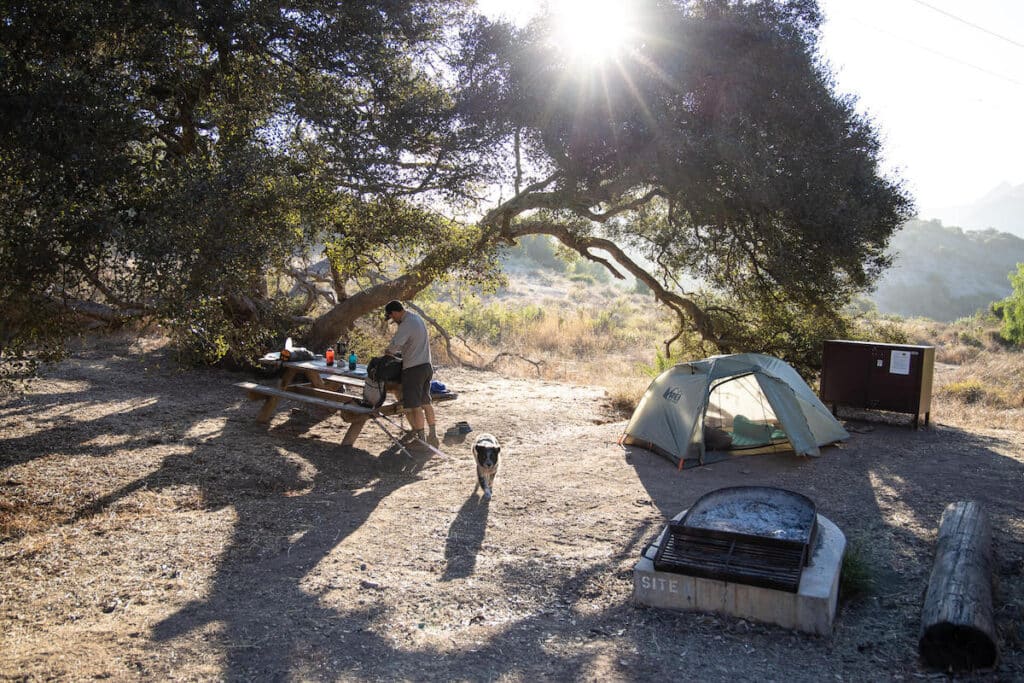
Getting to Catalina Island
Getting to the island is an venture in itself with the opportunity to encounter some big marine life like whales and dolphins during the 60-90 minute wend ride.
Be enlightened that the seas can get rough, so if you are prone to seasickness, plan ahead. I highly recommend taking ginger pills for seasickness and wearing Sea Bands.
There are two ferry operators that offer daily departures to Catalina Island:
- Catalina Express offers daily departures to Avalon from Long Beach, San Pedro, and Dana Point. However, they only provide service to San Pedro from Two Harbors for your return trip.
- Catalina Flyer offers daily departures to Avalon from Newport Beach. They do not offer ferry service to/from Two Harbors.
Another option for getting to Catalina Island is a 15-minute helicopter ride from Long Waterfront to Avalon which runs up to $179 per person each way.
FERRY TIMINGS: There are a couple of options for timing your ferry rides to and from Catalina.
Arrival: You have two options for arriving on the island:
- The first is to take the primeval ferry of the day so you get to the island as early as possible. The primeval ferry leaves Long Waterfront at 6:00 am. Ferries from and San Pedro and Dana Point are later in the morning. It’s roughly an hour’s ride to Avalon, so remember, you have an 11-mile day superiority of you so time is of the essence!
- Alternatively, if can
leave the night before and stay in a hotel if it’s in your budget. Avalon has a limited number of hotels to segregate from. You can moreover zany for a night in the Hermit Gulch Campground which is just a short walk from Avalon.
Departure: The Catalina Express doesn’t run every day from Two Harbors to San Pedro, so be sure to check their schedule surpassing planning your trip.
I recommend getting a late afternoon ferry from Two Harbors, so you can have a nice nippy morning at Parson’s Landing campsite.
If you don’t want to sail to San Pedro from Two Harbors, the Wildland Express is a bus shuttle service between Two Harbors and Avalon. Reservations are required.

Navigating the trail
The TCT is pretty well-marked, but I still highly recommend stopping in the Catalina Island Conservancy shop to pick up a detailed Trans Catalina Island Trail map.
While most of the trail was well marked, there were a few areas where we got tumbled on the route, so having a nonflexible reprinting of the map veritably came in handy.
The map moreover indicates the location of water sources, bathrooms, food, and other amenities withal the trail.
My TCT Trip Report
I hiked the Trans Catalina Trail in 5 days. Here’s my detailed trip report.
Day 1: Avalon to Black Jack campground (10.7 miles)
- Potable Water Availability: In Avalon and at Black Jack Campground
- Best Campsite at Black Jack: #1 (most secluded)
We opted to take an early ferry from Long Beach. Once we got to Avalon, our first stop was the Catalina Conservancy office (its on the way to the trailhead). There, we grabbed a map, learned a little bit well-nigh the wildlife and island, and asked our last-minute questions well-nigh the route. (Note that they dont unshut till 8:00 am).
Next, we filled up water in town at one of several spigots. Also, if you need any last-minute forgotten items there is Vons Express right lanugo the road from the ferry terminal. However, it’s not like a big grocery store on the mainland and it’s expensive, so you’ll want to bring most of what you plan on eating with you. Trammels out this post on Lightweight Vegan Backpacking Supplies Ideas for my favorite easy trail meals.
We took our time walking withal the waterfront and grabbed breakfast, which meant we got a late start on the trail.
To shave off a little bit of mileage, we hiked up whilom Avalon withal Stage Road and met up with the Trans Catalina Trail near Haypress Reservoir.
It was a steep takeoff withal a fairly well-traveled road. Once we finally unfluctuating with the trail, it was up-down-up-down-up.
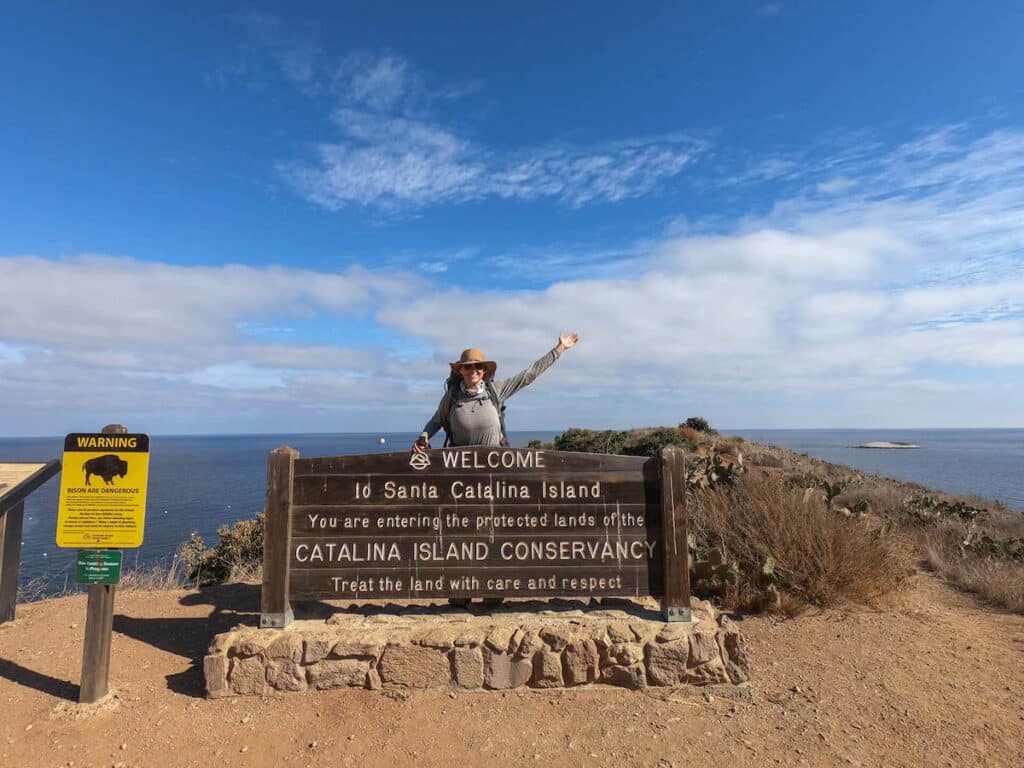
This part of the trail is the longest stretch you’ll go without seeing the ocean. It’s moreover very hot and dry. I was glad to have trekking poles, sun protection, and plenty of water.
We arrived at our campsite (Black Jack #1) right at sundown without 5 straight hours of hiking.
At the time of our visit, no campfires were unliable due to severe drought conditions. However, at other times of the year, you can pay for a locker full of firewood surpassing you leave Avalon.
If campfires are unliable while you’re there and you decide to have one, be sure you understand safe campfire practices.
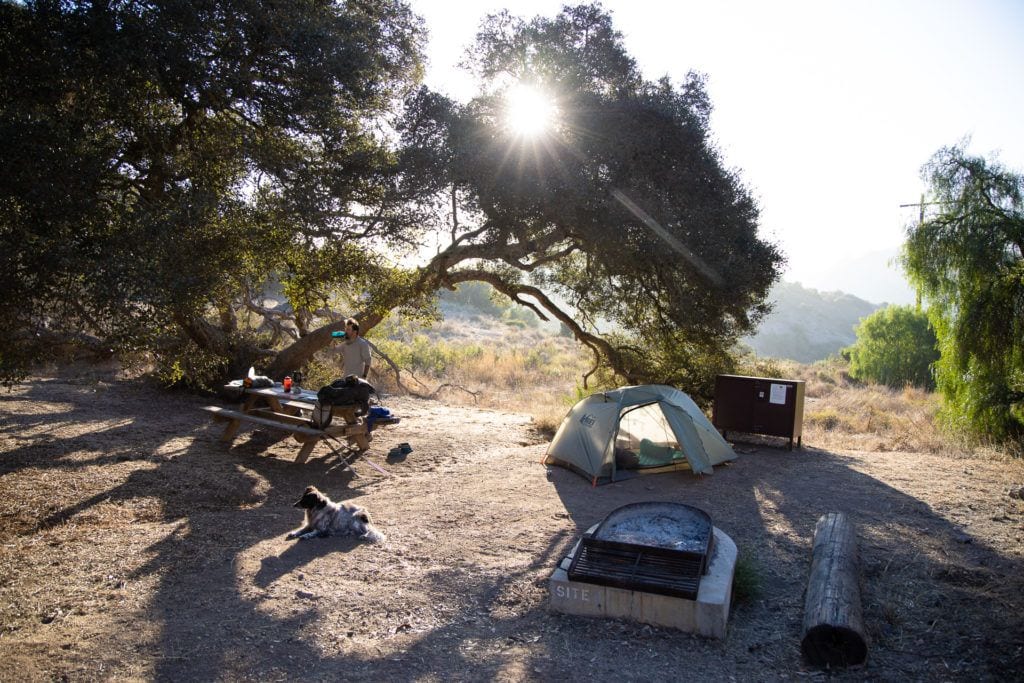
Day 2: Black Jack to Two Harbors (8.2 miles)
- Potable Water Availability: At Black Jack Campground, the Airport, and Little Harbor
Best Campsite at Little Harbor: LH12, SH 8, SH 9, SH 10 - For Firewood at Two Harbors: Undeniability 310-510-4205 the day surpassing your inrush and place an order. It’s $10 per small stow (which burns for approximately 1.5 hours).
Rise and shine! One of the weightier parts of todays hike is that you get a quick unravel without a short 2.25 miles when you victorious at the Catalina Island Airport.
The Airport in the Sky Restaurant (in the airport) opens at 8:30 am and is unshut year-round for breakfast burritos, freshly baked cookies, and more.
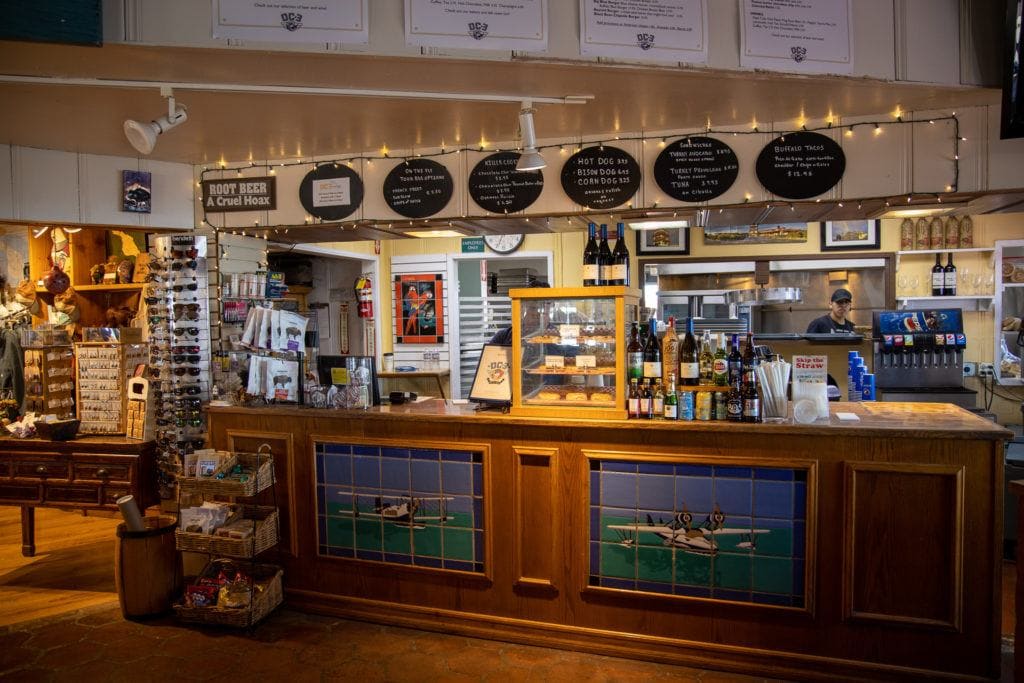
From the airport, it’s a little increasingly than 5 miles to Little Harbor. Withal the way, youll notice a VERY untried patch of land, which is unquestionably home to the Santa Catalina Island Vineyard. Dont get too excited…they dont offer tastings, but it is still a pretty unique sight to see.
Youll moreover notice some very nice buildings which subsume the El Rancho Escondido – the former working Arabian Horse Ranch owned by the Wrigley family (as in the founder of Wrigleys gum). The family that owns the vineyard and winery is working to restore the ranch.

Tip: If you are hurting or the trail is proving to be harder than you thought it would be, you do have the option to take a Catalina Island Conservancy Wildlands Express Shuttle from the airport to Little Harbor.
Once you start walking downhill, you’ll know you are getting tropical to Little Harbor which consists of two gorgeous tiny coves – Shark Harbor and Little Harbor – your home for night two.
We had campsite LH10, which was right on the beach. The weightier site, in my opinion, was LH12, which was beachfront and had increasingly privacy.
For maximum solitude, snag one of the spots next door at Shark Harbor – LH Shark A, B, or C. I’m not sure what the water situation was over there, so you may want to bring a large reservoir so you can siphon it when to your campsite.
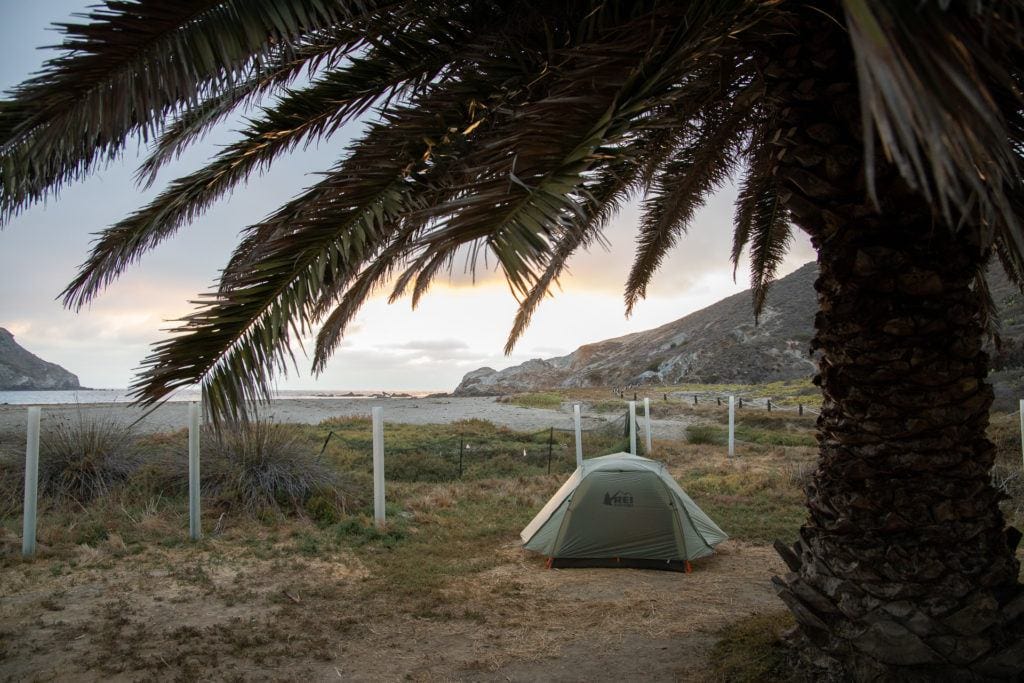

Apparently, the snorkeling and fishing in this zone are among the weightier on the island. At a minimum, you should strip off your boots and soak your feet in the sand and water.
This is moreover the last place you’ll have a sunset view on the TCT since it’s the last campsite that faces west.
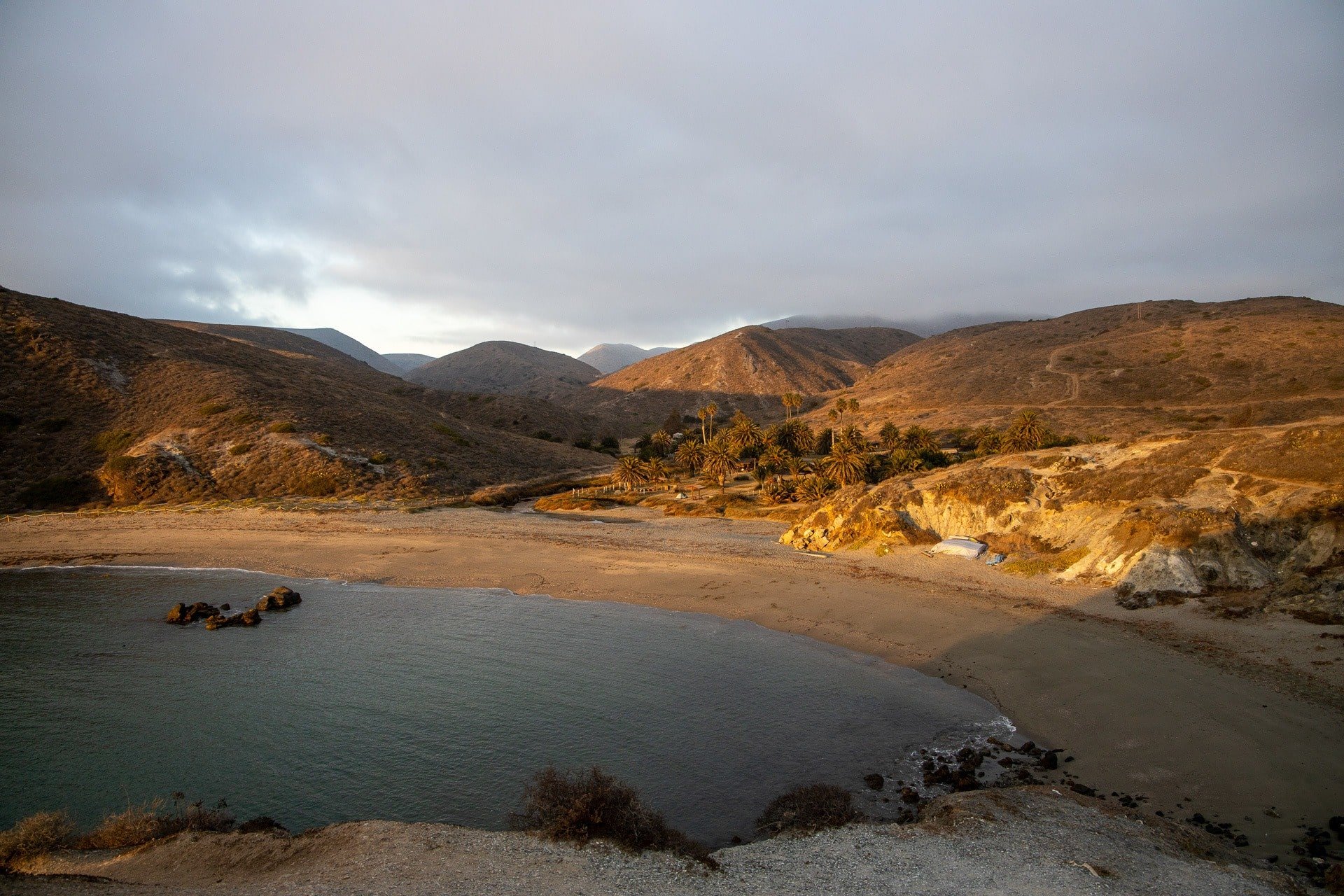
Day 3: Little Harbor to Two Harbors Campground (5.3 miles)
- Potable Water Availability: At Little Harbor Campground/ at Two Harbors Campground, you can purchase a 2.5-gallon jug from the ranger (we were told the tap water here is mineral-rich and doesn’t taste good)
- Best Campsite at Two Harbors: 11, 1, 2, 3, 4, 5
- For Firewood at Two Harbors: Purchase when you trammels in at the Two Harbors Visitors Center
After leaving Little Harbor, the hike to Two Harbors is no joke it is a difficult vertical climb, but youll be rewarded with some of the weightier views of the unshortened trip.
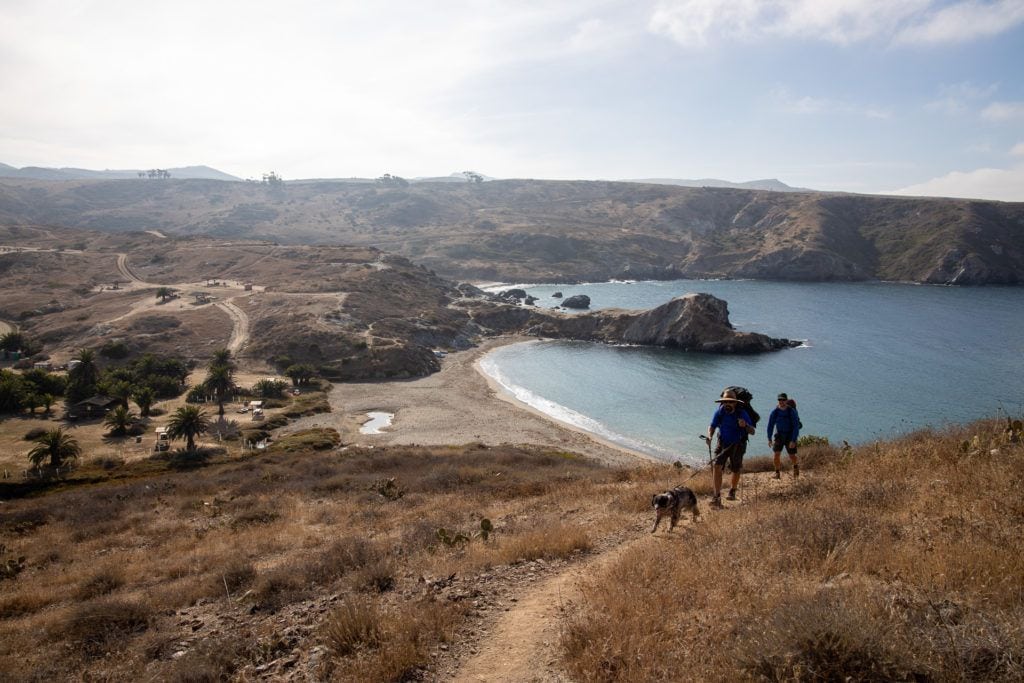
As you are unescapable Two Harbors youll be worldly-wise to stand on top of the ridge and literally see both sides of the ocean encompassing the western end of the island.
We moreover encountered a large herd of bison up on this ridge.
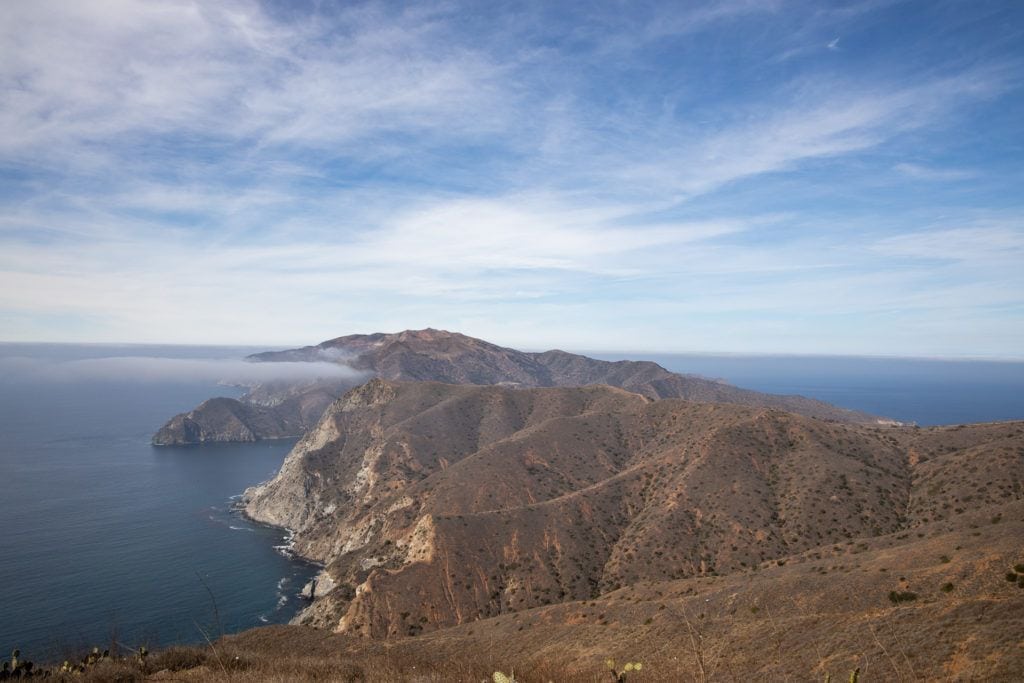
When you hit Two Harbors throne to the cute little grocery store for a reward treat. Whether that’s hand-scooped ice surf or a granola bar, you’ll have plenty of time to take a unravel here and plane grab lunch if you want.
Youll see the small pier that you’ll return to two days later when you are ready to workbench the Catalina Express when to the mainland.
Checking in for the Two Harbors campground can be completed at the little towers tying to the pier.
IMPORTANT: This is moreover where you will want to personize your Parsons Landing campsite and get your Parson’s storage key for water/firewood. As a reminder, there is no potable water at Parsons so you need to make sure you purchase the appropriate number of keys for your group so you have unbearable water for the rest of the journey. Each locker comes with 1 stow of wood and 2 gallons of water. Keys are not part of your Parson’s Landing camping reservation, so you will need to purchase one in whop or when you get to the Two Harbors Visitor Center. It’s recommended that you plan for 1 gallon of water per day per person.
We had Site #11 at Two Harbors, which had a fantastic view and felt fairly private. It was a small site however with only unbearable unappetizing space for 1 small tent.
Coin-operated hot showers are misogynist in Two Harbors if you finger like you need a bit of a clean-up! (There are unprepossessed showers misogynist for free).
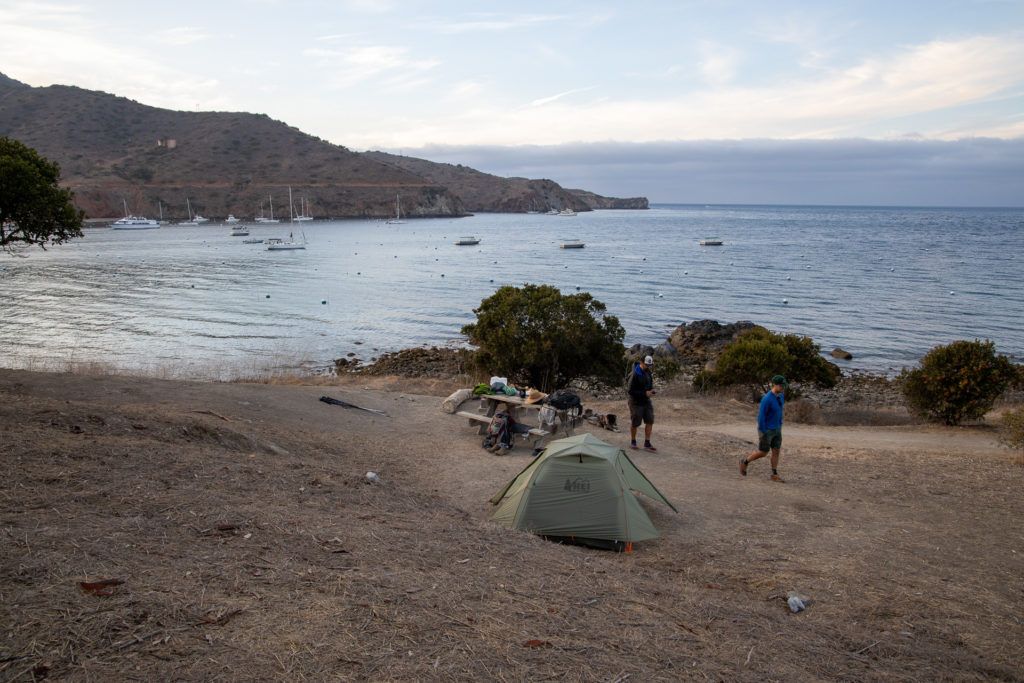
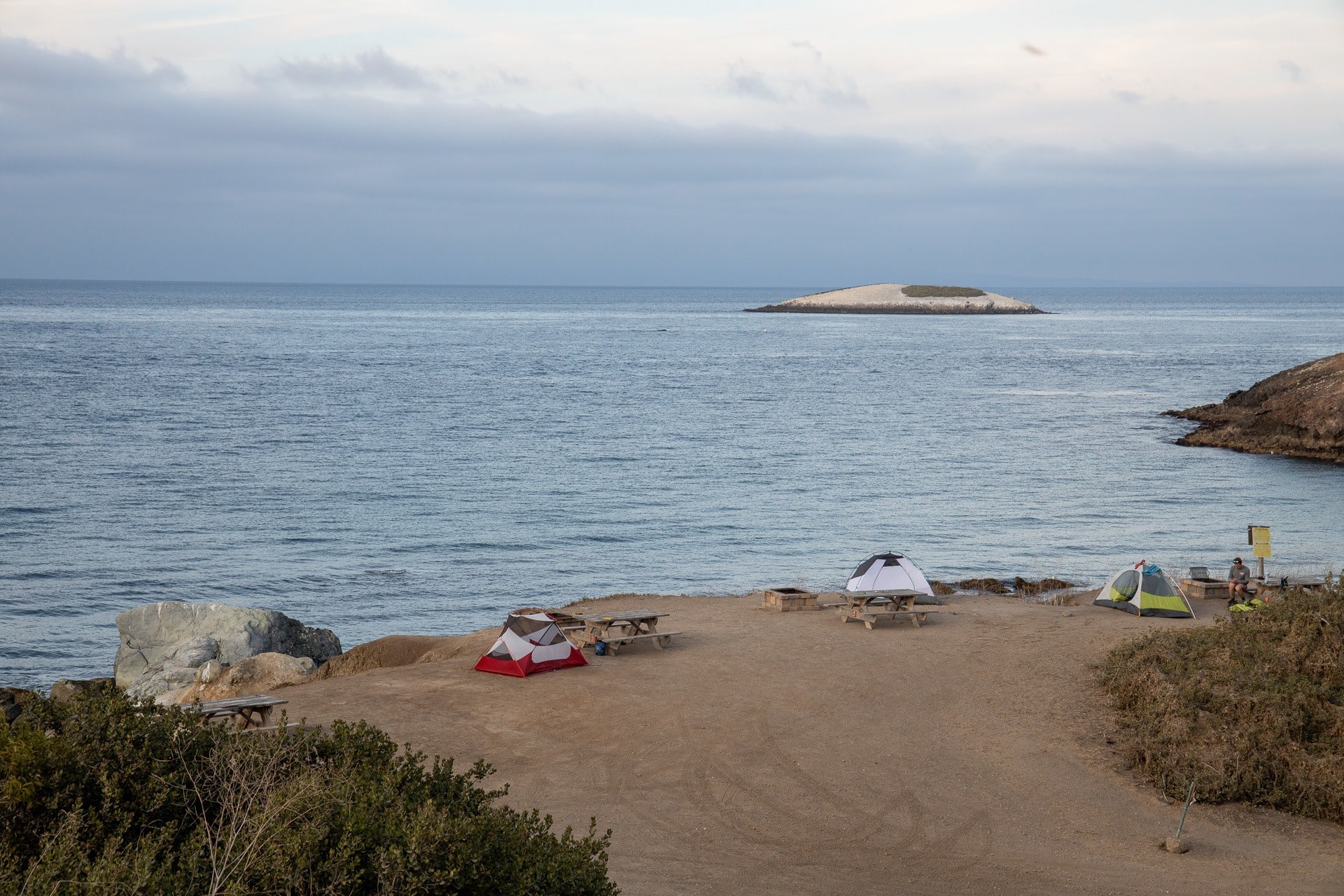
Day 4: Two Harbors to Parsons Landing campground via the TCT (6.6 miles)
- Potable Water Availability: For Parson’s Landing, you’ll need to purchase a locker key at Two Harbors surpassing you start the hike which comes with 2 gallons of water and 1 small stow of firewood
- Best Campsite at Parson’s Landing: 1, 2, 8
Leaving Two Harbors, you have two variegated options. The first is to hike through Cat Harbor and protract up and over the steep Silver Peak Trail, which is the official TCT route.
On this route, you’ll proceeds 1800 feet of elevation in 3 miles and then waif right when lanugo to sea lvel where you’ll reach Parson’s Landing.
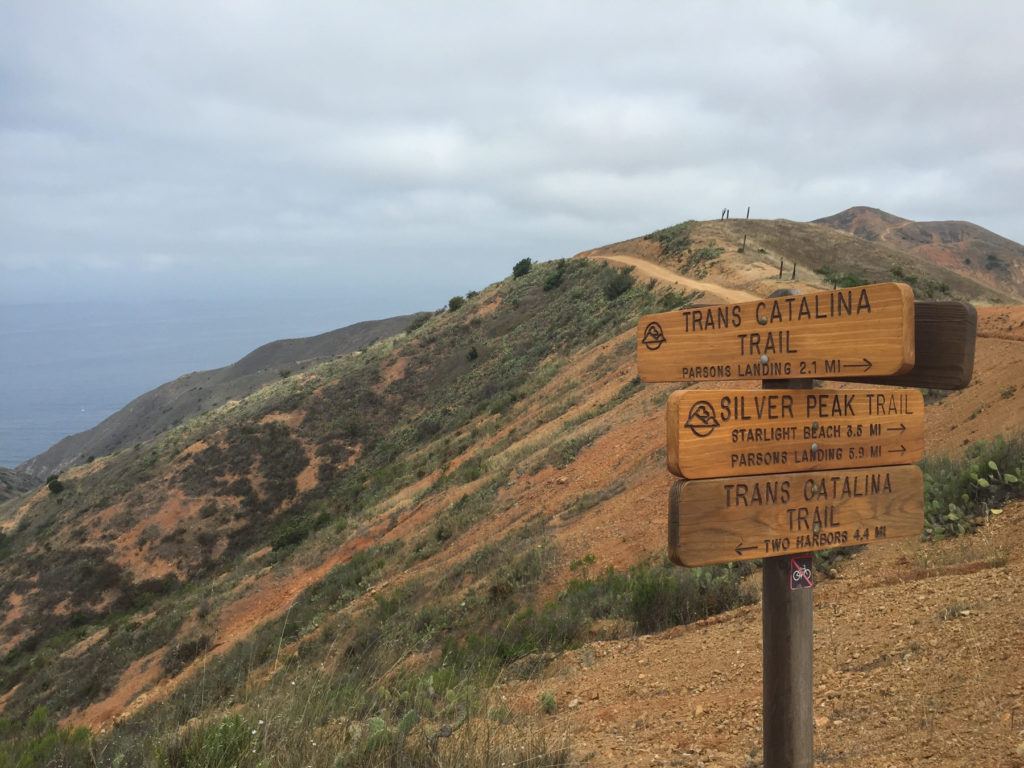
The other option is to take the cruisy route – 8 miles withal a dirt road that hugs the coastline the unshortened way. This is the route we chose in both directions. It felt a little like cheating, but it meant we had increasingly time to relax and enjoy our wondrous campsite at Parson’s Landing. Plus, we heard the descent from the upper route was a killer on the knees.
We hiked the road on a Thursday and only encountered a couple of cars. Withal the way, you’ll pass a few children’s camps, but otherwise, it was pretty quiet in November with non-stop views.
There are only eight primitive beachfront campsites at Parsons so you are going to finger that you are at a private beach.
We got lucky with site 1 which had the most protection from the wind and was very private. It was moreover the shadiest, which is good or bad, depending on the time of year and how much sun you want.

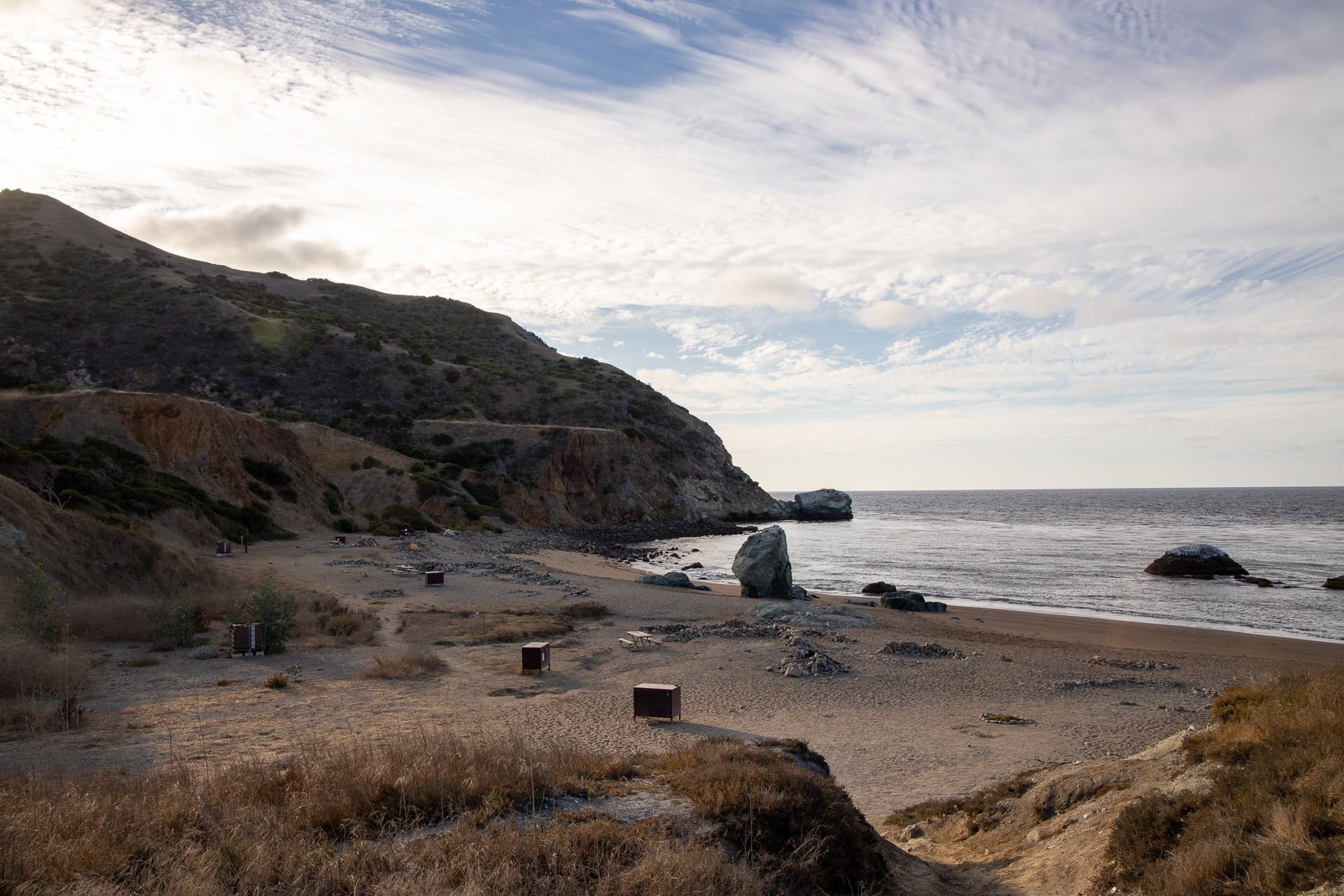
Optional Hike to Starlight Beach
From Parson’s, it is 5 increasingly miles to Starlight Waterfront – 10 miles roundtrip. If you’re into bragging rights and you have the energy, you can protract on to the very far end of Catalina Island.
We didn’t do this, but BFT Contributor Kim Vawter (who wrote the original version of this trail guide) did. We talked to a couple of other folks on the trail who made it to Starlight and said it was nice, but they weren’t sure it was worth the uneaten 10 miles.
If you do decide to go, make sure you store all of your supplies and water in your fox box at Parson’s surpassing you go and take a headlamp.
I’d moreover only recommend this in the summer months when the days are longer or if you plan to spend two full nights at Parson’s.
Day 5: Parsons Landing to Two Harbors via the road and Lion’s Throne (7.7 miles)
You’ve officially completed the Trans Catalina Trail! Congratulations. Now you just have to hike the 7.7 miles when to Two Harbors to reservation your ferry. One of the highlights of this section is passing the picturesque Emerald Bay.
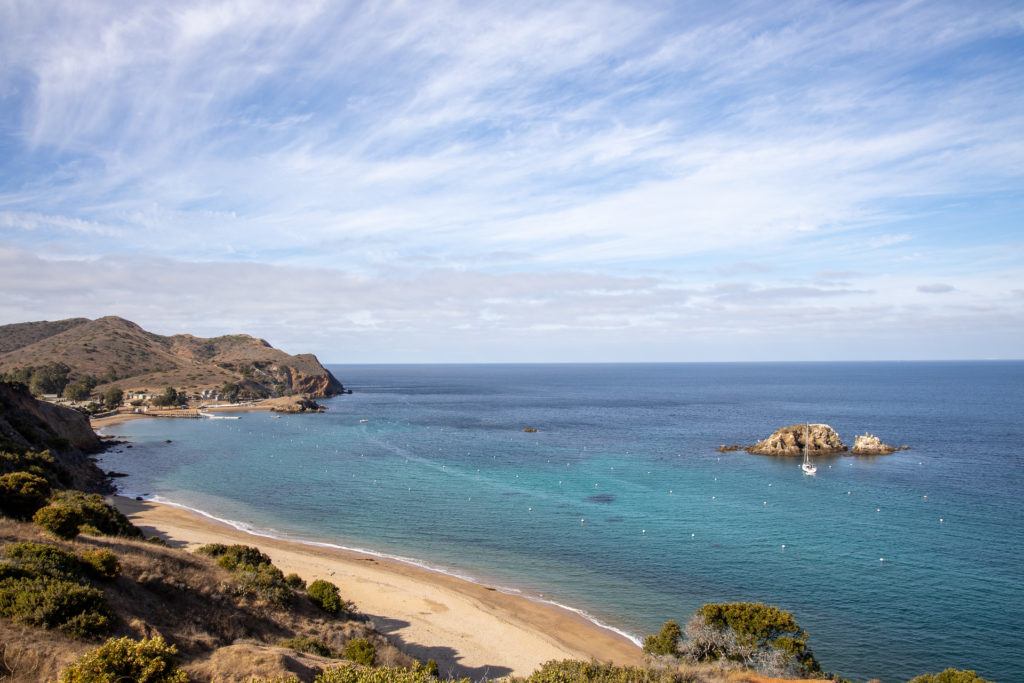
Make sure you time this last leg of your trip right so you don’t miss your ferry in Two Harbors.
I highly recommend arriving in town with at least an hour’s buffer surpassing your ferry boarding so you can enjoy a unprepossessed instillation at the Harbor Reef Restaurant. Grab a seat outside on the patio bar and let all the tension in your muscles melt away.
If you are feeling you need some time in the very water you can moreover zany flipside evening at Two Harbors and rent snorkel equipment or kayaks for the day.

Leave No Trace on the Trans Catalina Trail
There are a few important considerations in wing to your typical Leave No Trace recommendations when backpacking the Trans Catalina Trail:
- There is wildlife all over Catalina Island, including the island fox, bison, and some fairly warlike ravens. Never leave your supplies unattended. Most of the campsites have fox boxes (the same as withstand bins) where you can safely store your supplies and water.
- The bison are dangerous! Don’t tideway them for photos or any other reason. They can run 35 mph and are fully capable of taking you down. They are on the trail and in the campgrounds, so stay zestful and alimony an eye out for any warlike behavior.
- There are bathrooms. Please use them! And if nature calls when you are not near a bathroom, be sure to follow Leave No Trace guidelines for going to the bathroom and pack out your toilet paper.
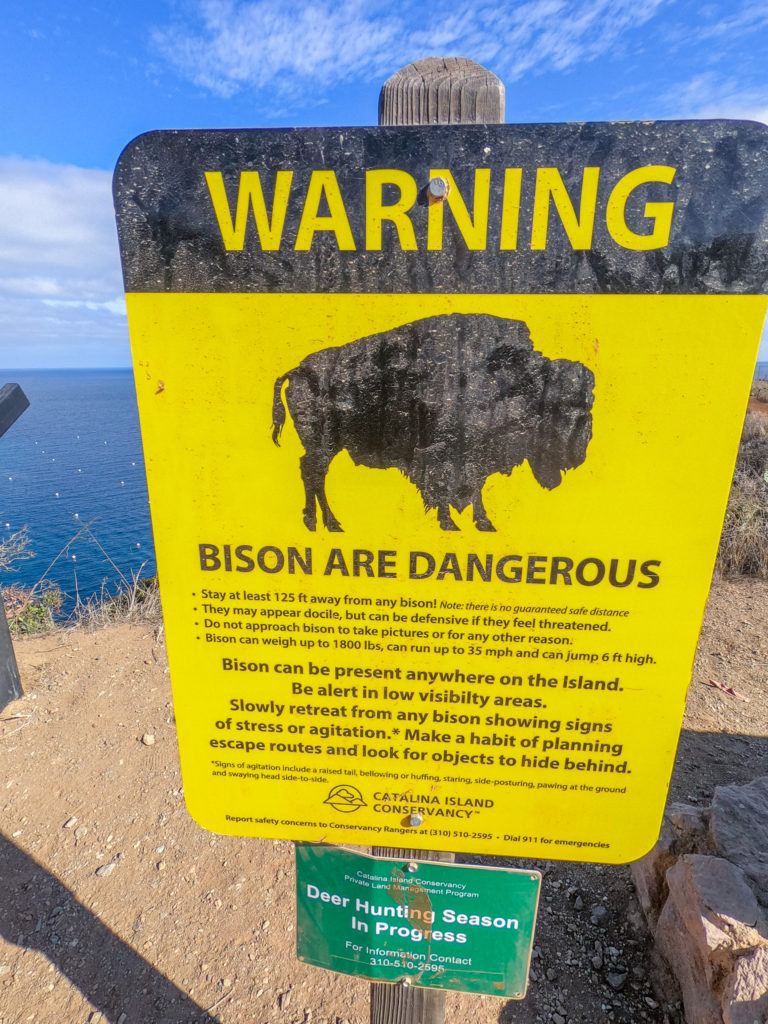
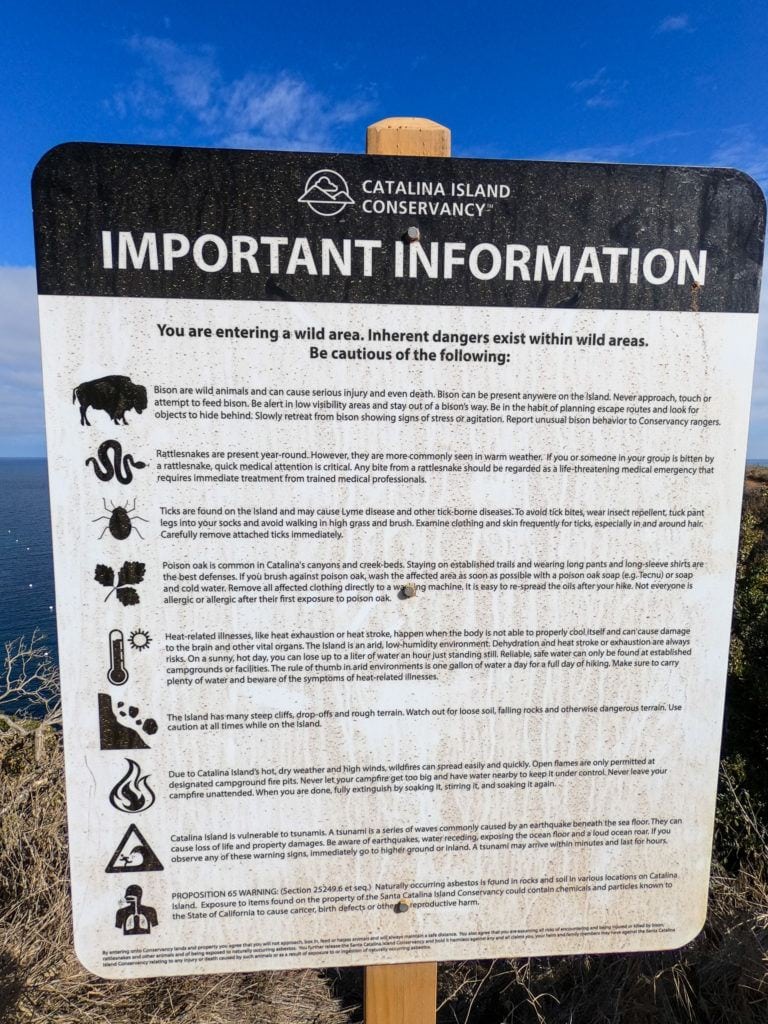
Trans Catalina Backpacking Gear
Start with this 3-day backpacking checklist. Unelevated I moreover recommend some specific pieces of gear that will be helpful on your TCT hike.
With the fox boxes at the campsites, you don’t need a withstand canister.
- Trekking poles will help protect your knees on the steep climbs and descents
- Wide-brimmed hat for sun protection
- Reef-friendly sunscreen
- Lightweight long-sleeved shirt for increasingly sun protection
- 3-liter water reservoir
- Swimsuit (if you want to swim)
Note that in November, evenings were very cold. I was happy to have a beanie, long pants, and a warm jacket for the evenings.
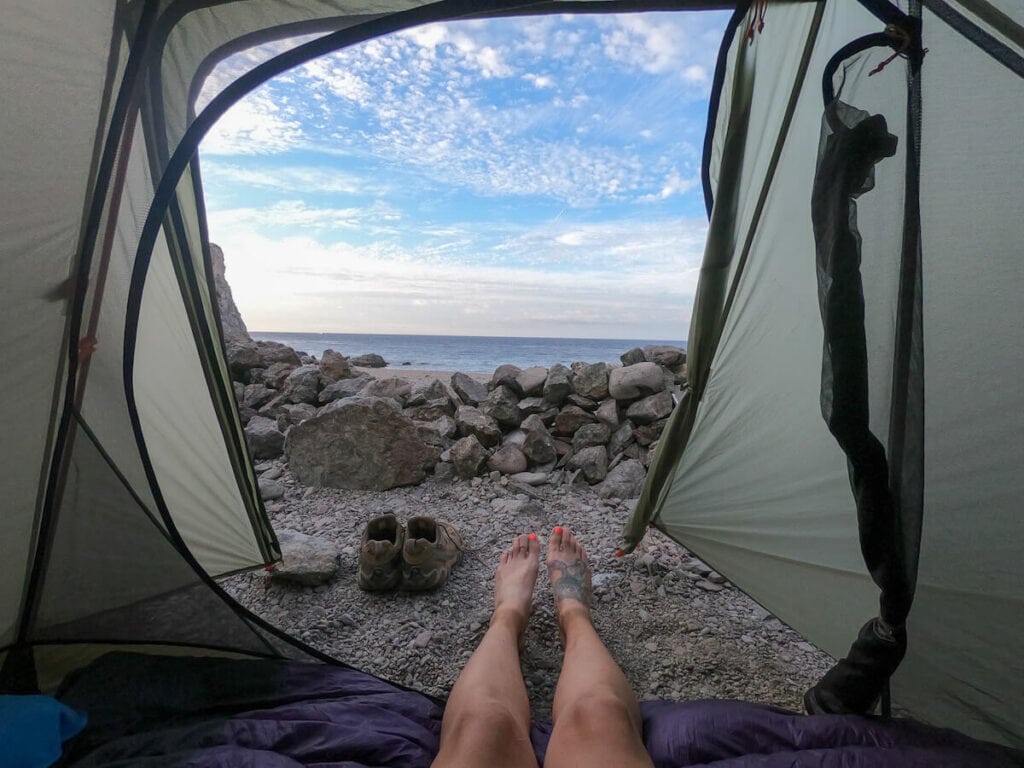
Save this post to Pinterest




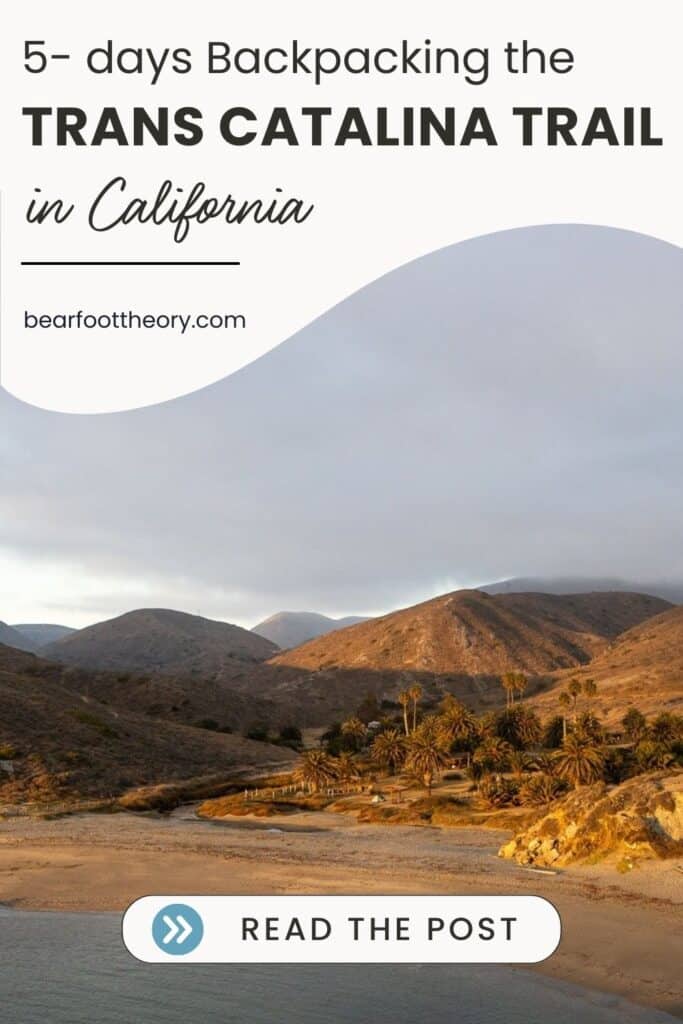
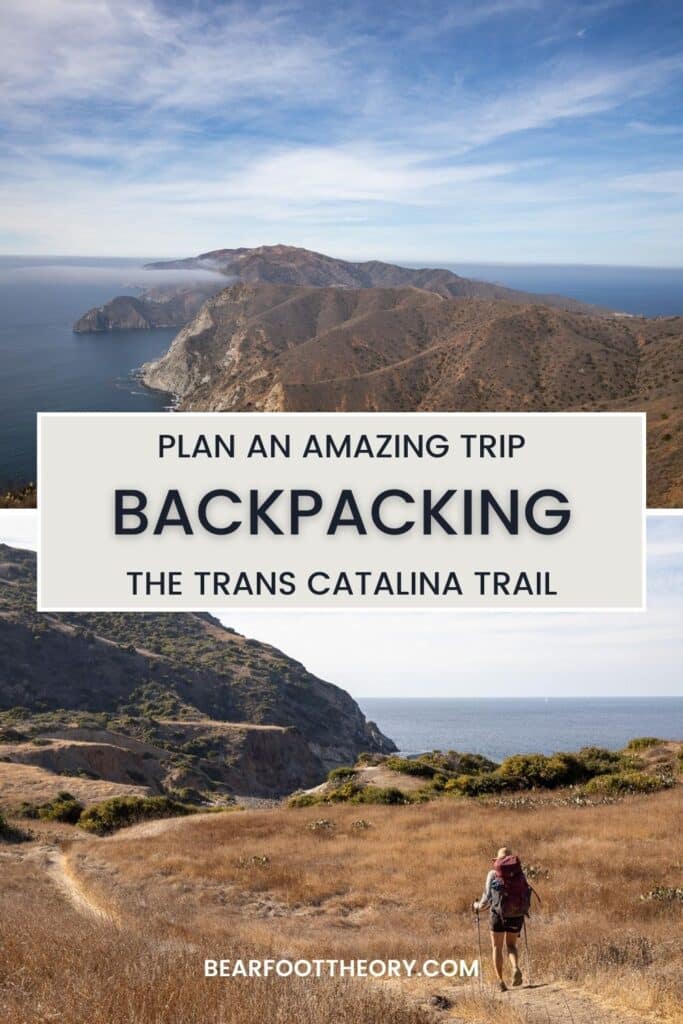

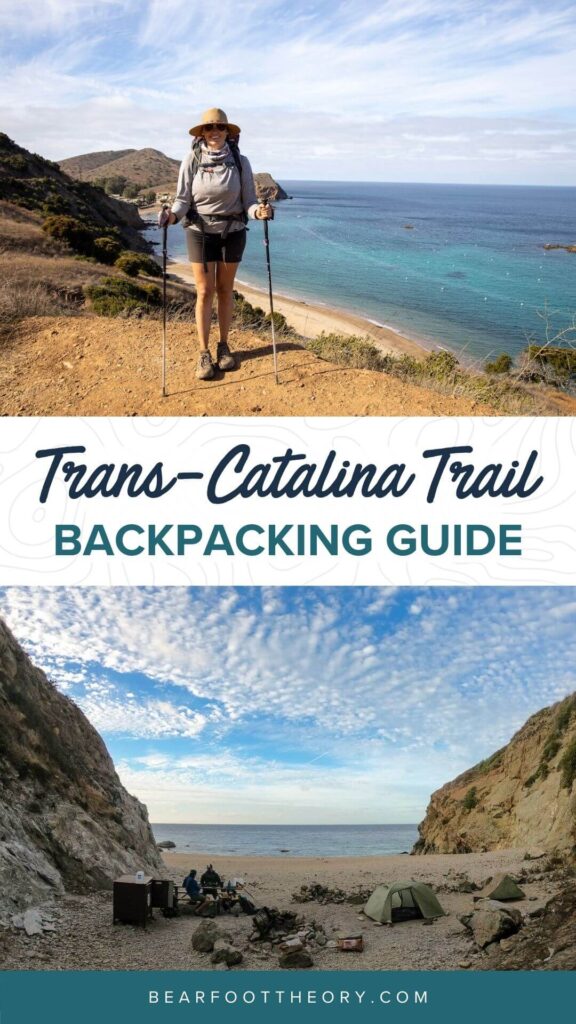
READ NEXT
Looking for increasingly backpacking trails? Trammels out some increasingly of our favorite routes:
Would you like to walkabout the Trans-Catalina Trail? Share your comments, questions, and experiences below.
The post Backpacking the Trans Catalina Trail: Permits, Itineraries, Gear and More appeared first on Bearfoot Theory.


